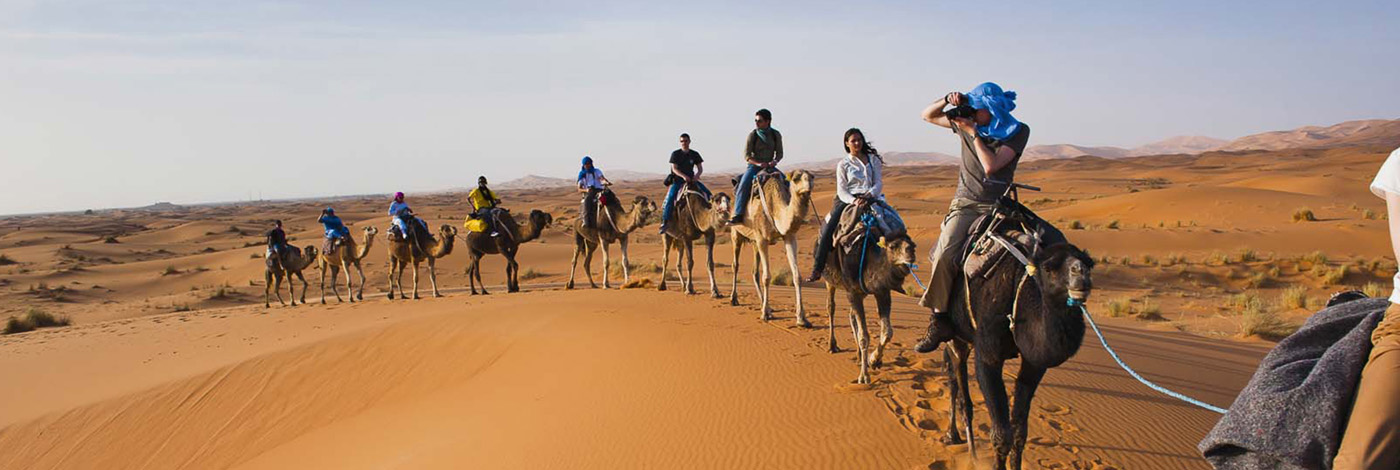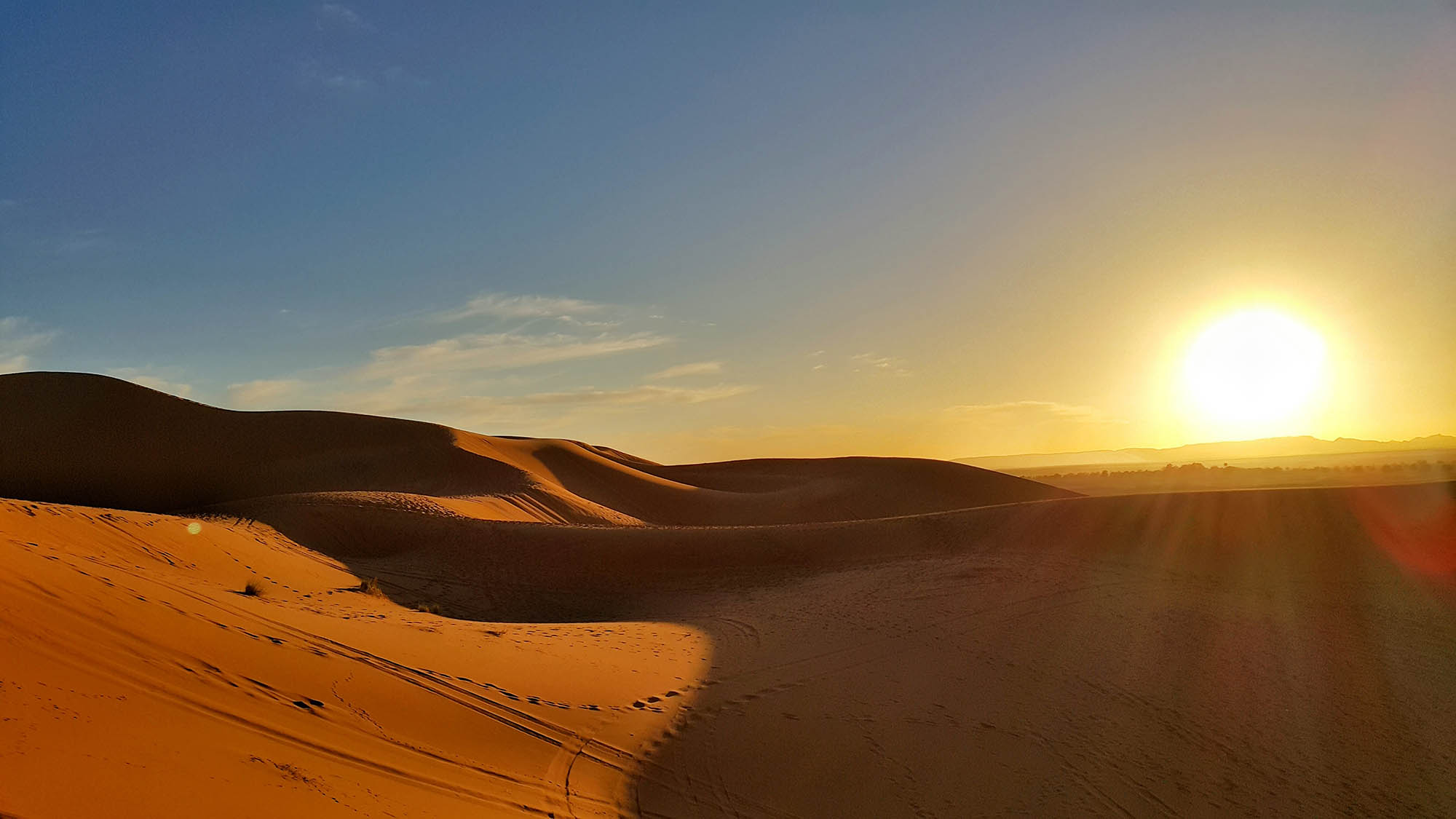About Morocco
At a glance
- Capital city: Rabat (population 1.6 million)
- Population: 34 million
- Language: Moroccan Arabic, French, Berber dialects, some Spanish, English
- Currency: MAD
- Time zone: (GMT) Casablanca
- Electricity: Type C (European 2-pin) Type E (French 2-pin, female earth)
- Dialing code: +212
- Best time to visit Morocco
- Culture and customs
- Eating and drinking
- Moroccan food is legendary
- Geography and environment
- History and government
- Top Picks
- Shopping
- Things to buy in Morocco
- Ramadan and Eid
- Gnaoua World Music Festival
- Casablanca Festival
The climate in Morocco varies wildly according to the season and area of travel. In the lowlands, the cooler months from October to April are popular among visitors. This time of year is pleasantly warm to hot (around 45°C) during the day and cool to cold (around 15°C) at night. Winter in the higher regions often brings snow and can therefore get seriously cold, particularly at night.
Tourists flock to the coastline from June to September for fun in the sun, with warm mostly rain-free days. Further inland it can get hot and rain is rare, which makes the best times to travel March to June and September to December.
As a Muslim country, Morocco observes Ramadan.
If you are planning to go on holiday in Morocco during Ramadan, it is important to consider that many restaurants and shops will either be closed or operating on reduced hours during this time.

Morocco’s culture has developed over centuries of influence from far and wide. Contemporary Morocco is a fascinating mix of Berber, Mediterranean, Andalucian and African traditions, which
are present in the cuisine, clothing, music, language, customs and lifestyle. As an Islamic country, most Moroccans are Muslim; however, there are small populations of people who practice
Judaism and Christianity. Classic examples of Islamic architecture can be observed all throughout the country and tenets of the Islamic religion are carried out in the customs and lives of the
people.
The ‘Call to Prayer’ can be heard five times a day, women are expected to dress modestly and alcohol isn’t drunk by most of the population.
Most of Moroccan society can be considered traditional, with respect for elders, connection to family and giving alms to the poor hallmarks of everyday life for many Moroccans.
Hospitality is another important element of society, with warmly welcoming people into your home a time-honored tradition and social responsibility that dates back centuries.
Toubkal adventures believes that one of the best ways to experience a country is by eating! Whether you’re sampling street food, savouring a cheap eat or indulging in a banquet, there are endless options to choose from wherever you are in the world.
Things to try in Morocco
1. Tajine
These slow-cooked stews are synonymous with Moroccan cooking. Chicken, olive and citrus is a well-known favourite, but there are endless variations using different meats, vegetables and seasonings.
2. Cous Cous
Forget instant cous cous and try the real deal in Morocco. Often served with vegetables and meat, regional varieties sometimes also include everything from sweet raisins to spicy harissa or smoky almonds.
3. Fresh Fruit
Morocco has an amazing array of fruit available in the markets, shops and juice bars. Choose from bananas, mangoes, oranges, avocados or peaches – eat fresh or get them whipped up in a juice.
4. Mint Tea
While travelling through Morocco you’ll probably drink more sweet mint tea than ever before. Offered as a gesture of hospitality when visiting someone’s home or shop, it’s considered impolite to refuse, so accept graciously.
Located in North Africa, Morocco has the best of many worlds within its boundaries. From the sun-drenched beaches of the coast to sands of the mighty Sahara and the snowy peaks of the High Atlas and Rif Mountains, Morocco has great variety in its landscapes and terrain. This combination of desert, woodlands, forest, mountain steppe and grasslands ensures a wide diversity of flora and fauna lives within the country.
Early History
The land now known as Morocco has been inhabited for centuries, with Moroccan civilisation being known for its richness in history and culture. Centuries of foreign trade, invasion and dynastic rule have given Morocco the many different cultural influences that are evident in today’s society. From the Phoenicians who entered Morocco via the Mediterranean in the 6th century BC, to the Roman influence of 40 AD and the formation of Islamic Morocco in the years after, Morocco has evolved with the rise and fall of dynasties, formation and dissolution of empires and birth of new governments, movements and ways of living. Reaching its height under the Berber Dynasties of the 11th and 12th centuries (the Almoravids, Almohads, Marinids and Wattasids), Morocco subsequently fell to Arab tribes in 1559. The current royal family are descendants of the Alaouite Dynasty who have largely ruled since the 1600s, despite enduring a few crises in the 18th and 19th centuries, mainly in relation to European influence in the area and surrounding countries.
Recent History
With the signing of the Treaty of Fez, Morocco was declared a protectorate of France in 1912 with Spain being allocated control of parts of Morocco, mainly in the north and south.
European control was generally opposed by Moroccans citizens, with the people of Rif attempting to establish a separatist republic in 1921.
Decades of opposition continued, with rioting and protests leading to increased political tension. In 1955, the road to Moroccan independence was paved by Mohammed V who negotiated reforms and restoration of independence. By 1956, France had relinquished its protectorate of Morocco and in 1957, Mohammed V became king. In 1961, Hassan II assumed the title of King of Morocco and continued to rule until his death in 1999. His son, Mohammed VI, took over the mantle of king in 1999, and continues to rule today.
Top 10 Must-See Places of Morocco
1. Marrakech
Things just happen in Marrakech. One moment you’re sitting down to a camel burger, the next you’re chatting to a snake charmer. The labyrinthine markets are the perfect place to lose
yourself but find a Moroccan memento or three.
2. Sahara
The endless dunes of the Sahara will call to your inner explorer. Jump on a camel and start riding out over the sandy waves. At sunset the desert glows rich and red and at night the
stars turn the sky crystal.
3. Essaouira
The name ‘Essaouira’ means image, appropriate since its charm is undeniable. Within the stone ramparts you’ll find art galleries, wood workshops and whitewashed houses
with bright blue shutters.
Portuguese, British and Jewish influences all mingle in this artist’s town.
4. Fes
Fes is the cultural heart of Morocco and home to some of its most iconic sights. Feel every sense come alive in the medina. Shops, dye pits and mosques all vie for space and you’re
as likely to see a donkey as a car.
5. High Atlas Mountains
The mountains are best explored at the ground level by foot or bicycle. Travel through Berber villages, up along crop terraces, down through lush valleys and past orchards, goats and
Moroccan rural life.
The seriously fit can tackle Mount Toubkal for incredible views.
6. Todra Gorge
This is a rock climber’s heaven, or the ideal place for beginners to get a taste. It’s a tight squeeze in some places but a sparkling river, the odd palmeraie, Berber villages and high cliff
walls make it worth breathing in for.
7. Moulay Idriss
The small Medina of ancient Moulay Idriss was once forbidden to non-Muslims. Now it is a pleasure to explore as the faithful gather to pay homage to the founding father of Islam in Morocco
at the 8th-century mausoleum.
8. Ait Benhaddou
Perfectly preserved, this is one of Morocco’s most picturesque kasbahs. Centuries ago it was a stop for caravans as they carried salt across the Sahara. Today, it is inhabited only by a handful
of families and the odd film crew.
9. Casablanca
The very name conjures up images of war-time romance. But the real romance of Casablanca must be its French influences and the beautiful Hassan II mosque, the largest in Morocco.
10. Volubilis
Do some time travel and visit the ancient hilltop city of Volubilis, one of the Roman Empire’s most remote bases. The ruins here are beautifully preserved and it’s easy to believe you’ve stepped
into the 2nd or 3rd century.
Morocco has one of the oldest retail cultures in the world. From bargaining in age-old souqs to swiping your credit card at a modern gallery, it’s all possible in Morocco.
But to experience brilliant bargains, exciting finds and a dose of history, you can’t go past the souqs.
It’s a good idea to check with your local customs officials to ensure that you are able to bring certain items back into your home country.
Australia and New Zealand generally have strict quarantine laws.
1. Silver Jewellery
Jewellery-fiends will love Morocco’s affinity with silver jewellery. Chunky rings, elaborate necklaces and patterned earrings can all be found for great prices, especially if you’re willing to haggle.
2. Tea Sets
Save room in your backpack for an iconic silver tea pot and some delicate tea glasses. Morocco’s silversmiths have this ancient art running through their veins, with centuries of craftsmanship being passed from generation to generation.
3. Leather
The quality (and price) of leather in Morocco is pretty phenomenal. Handcrafted hand bags, wallets, belts and purses can be found in almost every souq around the country.
Festivals and Events in Morocco
The ninth and holiest of months in the Islamic calendar, Ramadan is observed by most in Morocco and is thought to be a time of spiritual rejuvenation.
For this month, Muslims fast from sunrise to sunset – refraining from eating and drinking during daylight hours. Eid marks the end of fasting with 3 days of feasting and celebration.
Seaside Essaouira hosts this world-famous festival that celebrates the mysterious music of the Gnaouas, brought to Morocco centuries ago via the African slave trade.
Jazz, rock, blues and pop music add a contemporary flavour, although the drums of the Gnaouas are the true soul of the festival.
Touted as a ‘celebration of all things Moroccan’, this annual festival includes local and international music performances, dance, art installations, theatre, workshops and street parades.
This fusion of history and modernity, innovation and tradition is a shining example of what it means to be a citizen of cosmopolitan Casablanca.



